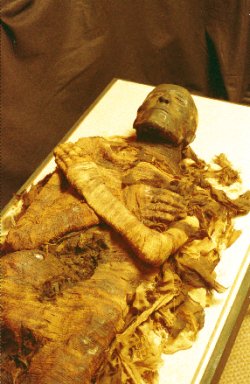
The Life of Egyptian Pharaoh Seti
Egyptian pharaoh SETI I, who died c.1304 BCE was a great warrior king of the 19th Dynasty. He was the father of Ramses the Great. His tomb in the Valley of the Kings is very large and is one of the longest found. However his mummy was not found in situ, but was found together with that of his son in the Royal cache, discovered at Dier el Bahri in June 1881.
Seti's massive stone sarcophagus was acquired in the 19th century by Sir John Soane, and is still on show at Sir John's house at Lincoln Inn Fields which is now a museum.
The mummy which was partially unwrapped by Gaston Maspero, is in a fine state of preservation and is virtually undamaged by ancient tomb robbers. The facial features are particularly impressive and show a hooked nose which becomes a particularly prominent feature of the Ramsid kings. The mummy is at present kept in the Egyptian Museum Cairo, where access is restricted.

It used to be thought that the body was then soaked for a long period in a bath of natron, a naturally occurring compound of sodium carbonate and sodium bicarbonate, although recent studies have shown it more probable that natron was used dry. This had the effect of efficiently dehydrating the mummy, dissolving body fats and leaving the skin supple.
The body was then padded, any incisions sewn up, and covered with a powerful protective talisman. The eye sockets were plugged with linen or set with artificial eyes. The body was then treated with resins, ointment and spices, and covered with bandages enclosing protective charms, the most important being the heart scarab. It was during the process of bandaging that the Egyptian embalmers tried to restore the original shape of the body. The internal organs were placed in four containers called Canopic jars with stoppers in the form of protective deities.
Egyptian pharaoh Seti built a temple complex at Abydos which included sanctuaries for various deities, notably Osiris and the king himself, and contained a kinglist in which Seti recorded the names of all previous kings who were still receiving offerings.
Here the king acts as the living Horus for every deceased king, that is to say every previous earthly form of his father Osiris. In these lists the sense of time as a long line of successive phases come closer to our 'concept of history, although the dominant belief remains focused on the two deities Osiris and Horus. The monuments of Egyptian pharaoh Seti are amongst the outstanding examples of Egyptian art.
Egyptian pharaoh Seti devised a large number of titles and epithets, many of them tied to different locations. All interesting example is the change in the name Seti when represented in the monuments to Osiris. Osiris was murdered by his brother Seth, god of chaos. The name Seti means 'He of Seth', so in order not to offend the god, Seti's name in Osirian monuments was not written with the hieroglyph for set but with the sign of the sacred knot of Isis with the sound of tit or set.
The unwrapping of the Mummy of Seti I
It was a masterpiece of the art of the embalmer; and the expression of the face was that of one who had only a few hours previously breathed his last. Death has slightly drawn the nostril and contracted the lips, the pressure of the bandages had flattened the nose a little, and the skin was darkened by the pitch; but a calm and gentle smile still played over the mouth, and the half opened eyelids allowed a glimpse to be seen from under their lashes of an apparently moist and glistening line, the reflection from the white porcelain eyes let into the orbit at the time of burial.
The Tomb of Seti I
The Tomb of Seti I, the father of Ramses II, is one of the most magnificent tombs in the Valley of the Kings. A fitting tomb for a great warrior pharaoh it is one of the longest tombs in the Valley, and descends hundreds of feet down in the rock.
The walls are covered with paintings of the major funerary texts, they include the text of the Litany of Re, scenes from the Book of What Is in the Underworld, the Book of Gates and the Book of the Heavenly Cow.
At various places Egyptian pharaoh Seti is shown making offerings to the gods. The mummy Opening of the Mouth and the ritual offering list is also included. In the burial chamber itself, the walls are covered with scenes from the Book of What is in the Underworld, while the ceiling is painted as a astronomical map of the heavens.
The tomb was discovered by Giovanni Belzoni who on his return to Britain constructed a replica for public view in London.

intro | home | egyptian mummies
shop | mummification process | mummy facts
mummy links|egyptian mummies exhibition
| egyptian mummy pictures | find us